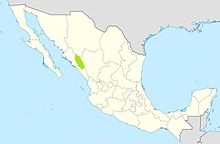Acaxee
The Acaxee were a group of closely related indigenous peoples of the Sierra Madre Occidental in the east of Sinaloa and northwest Durango in what is now northwestern Mexico , who later united to form a people due to epidemics and wars. Culturally, due to their way of settling in several scattered rancherías , like many neighboring tribes, they are counted among the so-called Ranchería tribes.
Life
They lived in the Sierra Madre Occidental in rancherías (settlements) scattered in ravines and canyons. Along with the neighboring Xiximes , Pacaxee and Tahue , the Acaxees were farmers and gatherers. Between the Axaceae and the Tarahumara (Rarámuri) living in the north , the Cahita-speaking Yaqui and Mayo as well as the Tepehuán living in the east and the groups mentioned above, there were repeated wars and conflicts; It was reported by Jesuits that the Axaceae practiced ritual cannibalism on killed enemies in order to take over their powers. In 1601 they undertook a revolt against the Spanish colonization, which was bloodily suppressed. In 1611 and 1616 they took part again in the Xixime rebellion and the Tepehuán rebellion.
Groups of the Acaxee
- actual acaxee
- Papudo
- Tebaca (along the Culiacan River, Sonora)
- Tecaya
- Sabaibo or Sobaibo (along the Río San Lorenzo, Sonora)
language
Their language, the Acaxee (Aiage) , comprised several dialects, such as the Tebaca and Sabaibo , and is closely related to Tahue and probably to Xixime (Jijime) . It belonged to the Cahita branch of the Taracahitic languages ( Taracahita or Taracahitan ), which belong to the southern branch of the Uto-Aztec language family .
literature
- The Acaxee: a mountain tribe of Durango and Sinaloa . University of California Press, 1934
- Thomas H. Naylor: The Presidio and Militia on the Northern Frontier of New Spain: A Documentary History - 1570-1700 . University of Arizona Press, 1986, ISBN 0-8165-0903-4 , books.google.de

